Starting Pecan Trees
There are four basic ways to establish a pecan tree: (1) plant pecans directly in place in the orchard and graft the resulting seedlings to the desired cultivar, (2) plant seedlings in the orchard and graft them to the desired cultivar, (3) plant a grafted tree of the desired cultivar or (4) transplant existing seedlings and top work to the desired cultivar. Each of these methods has its advantages and disadvantages.
Starting With Nuts
Starting an orchard by direct seeding is initially the most inexpensive way to plant an orchard, but requires more time before the tree is large enough to graft. Planting seeds in place is generally not recommended because of problems with weed and varmint control, and the long start-up time.
Starting With Seedling Trees
Seedling trees can be bought from a nursery or can be grown from stratified nuts planted in a nursery block or in containers. The seedling trees can be planted in place and grown for at least a year before being grafted. Advantages include ability to select cold hardy rootstocks, lower tree costs, and ability to graft to a wider selection of cultivars. Seedling trees also offer a chance to graft above the soil line (at least 18 inches) to improve cold hardiness.
Starting With Grafted Trees
Using grafted trees is the quickest way to get an orchard into production, but can also be the most expensive. The rootstock may be unknown, and the graft is normally at ground level, reducing cold-hardiness. These grafted trees may be container grown or bareroot trees. A grafted container tree is usually more expensive, but offers the grower some flexibility in planting time. Bareroot trees are dug during the dormant season and shipped for planting in late February to mid-March. Many successful orchards have been established using grafted nursery trees.
Starting With Transplanted Trees
In many native groves, small seedlings germinate and begin to cover the orchard floor. Growers can select and mark small seedlings to save before mowing. The existing seedling will be well suited to the area and can be grafted before or after transplanting. These trees can later be transplanted into rows with a tree spade. Transplanting trees is normally done during the dormant season. This method of establishment can bring an orchard into production very economically and quickly.
Seed Preparation
When either planting seeds in place or planting seedling trees, the first step is to select high quality seed. Seed should be collected in the fall. Select pecans that are well filled and insect-free. Seed from northern cultivars, ‘Giles’ and ‘Peruque’ or natives from the immediate area or a more northern location will produce more cold-hardy trees than southern rootstocks such as ‘Elliott’ or ‘Riverside.’ ‘Apache’ produces seedlings that are more vigorous than ‘Giles’ or ‘Peruque,’ and in many instances tree cold hardiness is similar to those grafted onto ‘Giles’ or ‘Peruque.’ Seed should be stratified. Stratification is a period of moist and cold temperature that mimics the outdoor conditions a buried pecan would receive in nature. The cold moist condition reduces time to germination and allows for a more uniform germination. Stratification also produces more vigorous seedling growth. To stratify pecans, they should be soaked in tap water for 24 hours to fully hydrate. Vermiculite, available at garden centers, should be wet and allowed to drain overnight. Mix the pecans and moist vermiculite in a labeled plastic bag and place in a cool area 36 F to 40 F. This stratification process should take at least two months and can be kept for five months to six months in the recommended temperatures.
If planting in place, seeds can be planted in February or March. When growing container trees, it is best to wait until after the threat of frost to plant outside. In central Oklahoma, frost is unlikely after April 15. If greenhouse space is available, the seeds can be planted after the stratification process and a larger tree can be grown. A greenhouse seedling will need to be hardened off slowly to the outdoor conditions after the threat of frost.
To eliminate non-viable seed and reduce soil and container costs, seed can be pre-germinated. Remove the stratified seed from the vermiculite. Rinse the seed thoroughly to remove vermiculite and inspect and discard any cracked, open, or molded nuts. Select a container to fit the number of seed. A plastic pitcher or 5-gallon bucket both work well. The water should be aerated. An aquarium pump with air diffusers or bubble stones will aerate the water. A carefully monitored aquarium heater set to 90 F will speed up germination. Prior to germinating the seed, test the aquarium heater for a few days to get an accurate temperature. The water should be changed daily to remove growth inhibitors that are leached from the seed. The seeds should be rinsed and inspected. If any seeds have become rotten or slick, discard or they can decrease the germination rate. When the radicle begins to emerge from the nut, it is time to plant. If allowed to grow too long, the radicle becomes fragile and is easily broken during planting.
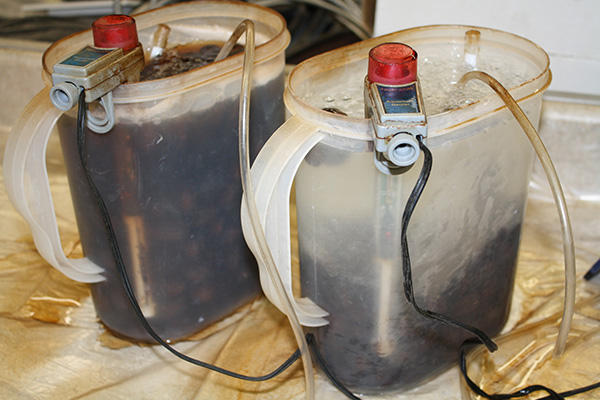
Pre-germination will eliminate non-viable seed. One pitcher with fresh water and a second pitcher shows water after one day. Water should be changed daily.
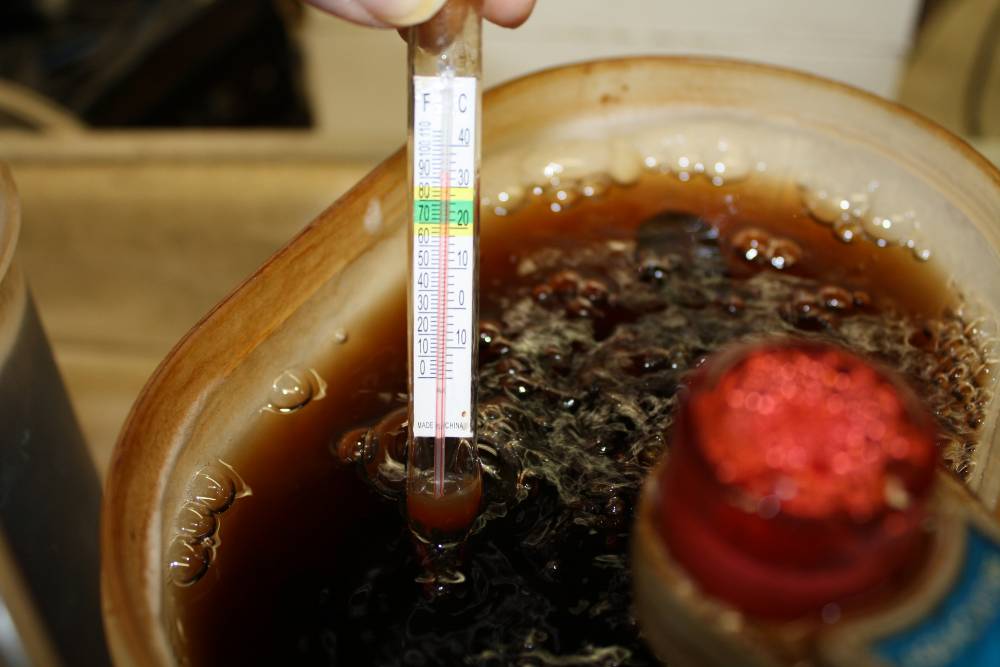
Germination can be sped up by maintaining the water temperature at 90 F. If is allowed to get too hot, the pecans will not germinate.
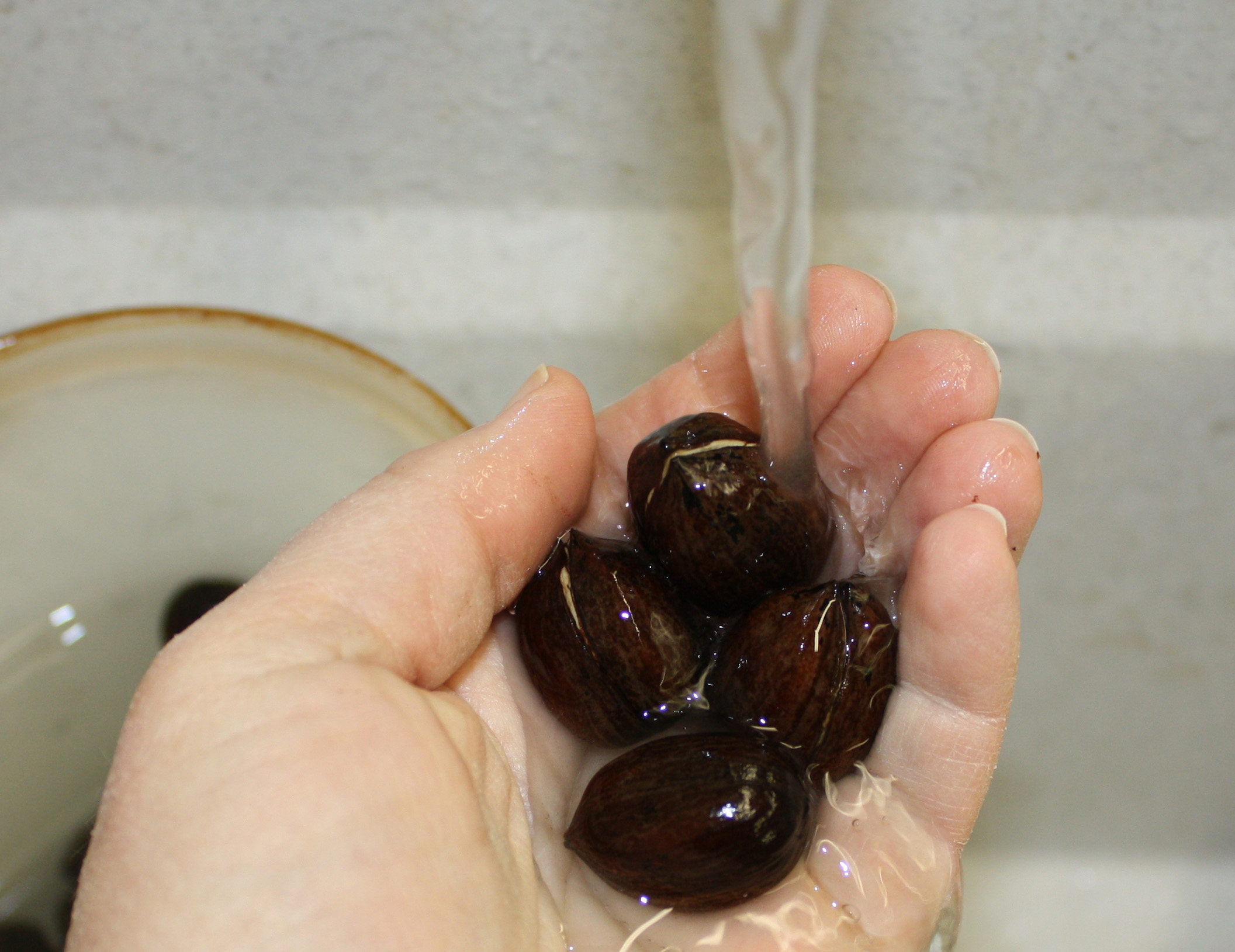
Change the water daily to eliminate leached tannins from the shell. Rinse pecans carefully and discard if cracked or slick.
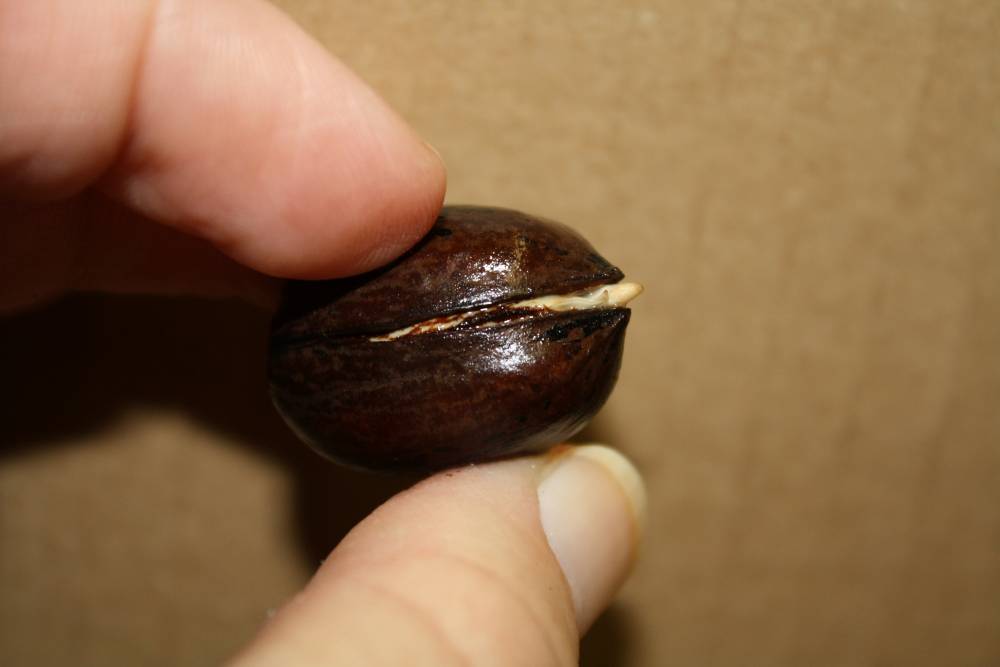
When the radicle begins to emerge from the shell, the pecan should be planted. If the radicle grows too long while germinating, it can easily break off and be useless for planting.
Growing Container Trees
A support system or rack should be in place to keep the pots upright and off the ground. The rack should have a bottom made of hardware cloth, expanded metal or some type of open bottom to allow for air pruning the roots. When the tap root reaches the open bottom of the pot, the roots stop growing and then develop more fibrous roots. Air pruning of roots helps to reduce the “curly root” of nursery trees. Recommended pots are 4x4x14 or 4x4x10 inches. Choose a soilless nursery mix that will allow for good aeration and water holding capacity. A soilless media with bark, peat and sand such as Metro Mix 300 is recommended. Plant the nuts on their side about 1 -1 ½ inches deep. Cover with media and water carefully. Each watering should drain through the pot. Do not allow the pots to dry out or the leaves will show signs of scorch.
If mice, birds, squirrels or raccoons become a problem, a net or chicken-wire cage may be built to protect the pecans and small seedlings. One squirrel or raccoon can dig up and feed on many pecans in one night.
When the seedlings have grown to 2 inches to 3 inches tall and have two true leaves, apply a slow release fertilizer such as Osmocote 13-13-13 at a rate of 0.5 oz/pot or 1 tablespoon. If applied too early, the fertilizer will damage tender seedlings. A micronutrient solution such as Peters Soluble Trace Elements Mix (STEM) at 45-day intervals should be applied at a rate of 2-oz/100 gallons or about 2 teaspoons per gallon water. After the pots are well watered, apply the STEM drench until leaching through pots. The Osmocote application should be repeated monthly and the STEM drench every 45 days through July. Zinc sulfate sprays diluted to 1 to 2 lbs/100 gallons or 1 tablespoon per gallon of water should be applied at 2-week intervals until growth ceases.
Insect and disease scouting should be performed regularly and if needed, proper insecticides and fungicides should be used.
Hand weed as needed. Weed competition will decrease seedling growth substantially.
It is best to plant 20 percent more seeds than needed to allow culling at transplanting
time. Not all the seeds will grow as fast as others. The outside rows will be shorter
because they dry out sooner and are not competing for the sunlight like the inner
pots. Regular shifting of pots around the rack will force the trees to compete and
grow taller. Shade cloth can also help to get taller and more growth on the seedlings.
Trees should be planted in the field and grafted in 1 year to 2 years. Proper weed control and irrigation will speed up the time until grafting.
Growing container trees can be a time consuming endeavor. Overlooking an insect problem, a squirrel digging up seeds, or missing a watering may result in tree loss but growing your own seedlings can be a less expensive method of starting an orchard.

Seedling trees in June after mid-April planting with proper fertilizer applications, irrigation and weed control.
Planting Trees in the Field
Fact Sheet HLA-6247 – Establishing a Pecan Orchard will be helpful in site preparation. It is better to wait a year and have your site prepared properly, than to rush the planting and have problems that are hard to correct after the trees are in place.
Late September to mid-October is the ideal time to plant container trees, but they
can be planted into May. Pecan roots in the containers are not cold hardy and must
be planted before the first freeze. If the trees will be planted after the first freeze,
protect the root system by storing in a cooler, cellar or bury the pots in the ground.
For container trees, the hole should be just large enough for the roots to fit. If
using 4x4x14 inch pots, a hand post-hole digger or tractor auger works well. Do not
make the hole too large. During planting, remove the tree from the container, shake
excess potting media from roots, and trim the tip of the taproot before planting.
If the taproot is curled, cut above the curled portion. Place the tree in the hole
at the same depth or slightly higher than it is in the pot. A tree planted too deep
will not anchor properly. Tamp down the soil around the tree and continue to backfill
with soil. Be sure to settle air pockets by watering well. The top portion of the
tree does not need additional pruning at planting time.
If planting bare root trees, plant when the trees are dormant during January through March. Have holes dug before ready to plant. Holes should be deep enough to accommodate a root system 18 inches to 20 inches long. Soak the root system for a few hours to hydrate. Keep roots protected from wind and freezing temperatures. Cut taproot to 18 inches and prune side roots to fit the hole. Place tree in hole and fill in with soil, tamping as you fill. Make sure to plant the tree at the same depth or slightly higher than was growing at the nursery. Water the tree to settle the soil. Cut off one half of the top of the tree to balance the reduced root system. If the tree is grafted, be sure to not cut below the graft.
Transplanting existing seedlings from a native grove into rows is a very good way to start an orchard. The native seedlings can be grafted the year before transplanting or a year after they have been transplanted. It is best to give the transplanted tree time to establish before adding the extra stress of grafting.
Trees can be painted with white wash, wrapped with tree wrap or covered with trunk guards or grow tubes to reduce sunscald and deer rubs. The trunk guards will also prevent herbicides from coming into contact with the green trunk.
Weed and grass competition is very detrimental to new tree growth. Grasses and broadleaf weeds compete for moisture, nutrients and exude alleopathic chemicals from their roots that impede the growth of the tree. All these factors slow the development of the orchard and increase time to production. Herbicides strips or circles around the tree at least 6 feet will benefit the tree. Mulches, either organic or fabric also can be used to eliminate any interference.
During this establishment time, trees are more susceptible to drought conditions. Have an irrigation plan in place before planting the trees.
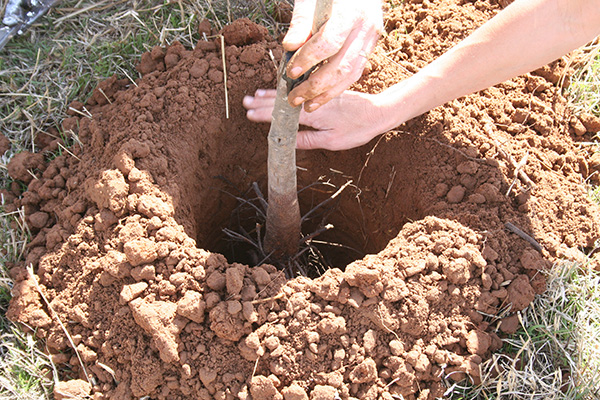
After cutting the taproot to 18 inches, the tree is placed in the hole so that the soil line is at the same location before the tree was dug at the nursery. (photo credit to Noble Foundation)
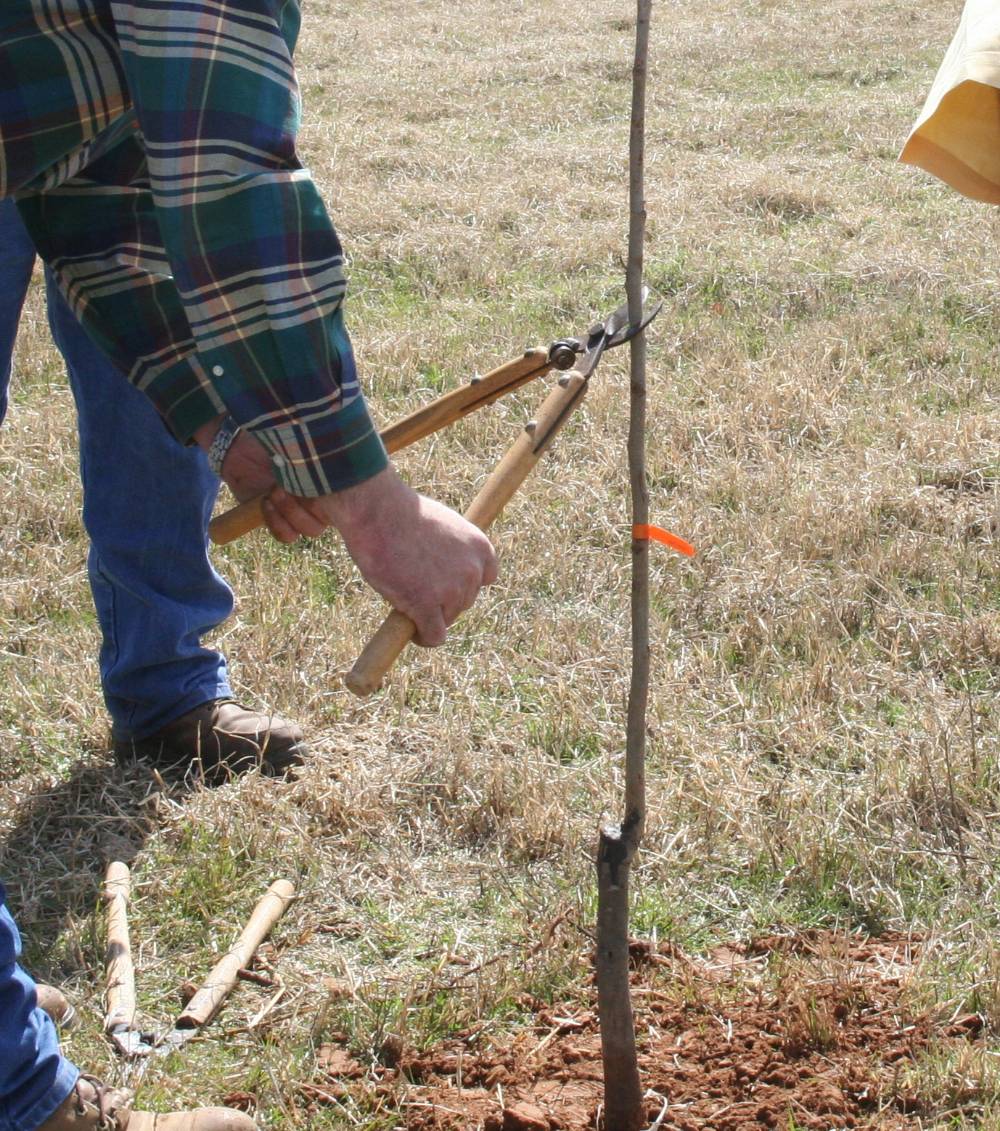
Once the bareroot tree is planted, the top should be pruned to balance the top growth with the reduction of roots during digging and planting. (photo credit to Noble Foundation)
Becky Carroll
Senior Agriculturist
